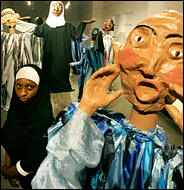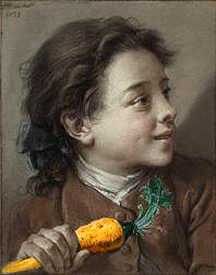7.27.2005
 When one of her students was picked up and detained by the government for six weeks without explanation, the class of Art Teacher (and CR Contributor) Kim Lane did not let her go quietly. Through the creation of larger-than-life paper mache figures, the students depicted the school's reaction to the event, exemplifying the power of art as a form of social protest and the resolve of students to have their voices heard. The project and subsequent outcome is detailed in this New York Times Article.
When one of her students was picked up and detained by the government for six weeks without explanation, the class of Art Teacher (and CR Contributor) Kim Lane did not let her go quietly. Through the creation of larger-than-life paper mache figures, the students depicted the school's reaction to the event, exemplifying the power of art as a form of social protest and the resolve of students to have their voices heard. The project and subsequent outcome is detailed in this New York Times Article.
Because the NYTimes does not offer free access to archived articles, please find the entire text of the article in the comments section here.
Tags: Activism
1 Comment:
Subscribe to:
Post Comments (Atom)















An Art Class's Lesson in Politics
By NINA BERNSTEIN
Published: July 25, 2005
When Adama Bah's schoolmates decided to make a public artwork project about her case last spring, she and another 16-year-old girl were being held by the federal government after it had identified them, without explanation, as potential suicide bombers.
"We didn't know if we would ever see her again," said Kimberly Lane, who was then an art teacher at the school, the Heritage School in East Harlem, where many viewed Adama's detention as unjust and incomprehensible. "This was a way for the students to use art to speak out at a time when a lot of people, including adults, were afraid to do anything."
The result towers over anything that most people would expect high school students to produce. At Columbia University's Teachers College, where the work is on display through Thursday, the director of art education, Prof. Judith M. Burton, says it reminds her of Rodin's "Burghers of Calais."
That comparison does not seem too outlandish when looking at the seven larger-than-life figures at the college's Macy Gallery, even though they are fashioned from papier mâché and wire covered with colored cloth. They stand and gesture in a dramatic ensemble, the smaller ones urgently calling for attention or trying to intervene, the larger ones looming silent, deaf and blind to the victim in their midst, who raises her arms to heaven in a plea for help.
Adama is at least two heads smaller than the seven-foot figure designed to look like her, but the similarity is unmistakable. She was released from detention in May without being charged with a crime, just in time to pose for the 12 student artists - and to witness their crisis when the project seemed too controversial for the law firm where they had expected to display it.
But nothing prepared Adama for the final result. "As soon as I walked in, I was, like, shocked," she said. "My mouth just dropped. It was beautiful."
The reasons she was held for six weeks in a Pennsylvania detention center remain a mystery, and she and her lawyer, Natasha Pierre, are still under a court order not to discuss the case. The other girl, Tashnuba Hayder, is now back in her native Bangladesh. Adama, who came to New York as a toddler from Guinea, is fighting to stay here regardless of what happens to her father, a former cabdriver who is in immigration jail facing deportation after losing political asylum, which he had won by falsely claiming to be from Mauritania.
The artwork does not parse such details, though a thick binder at the exhibit includes newspaper articles about her case. Instead, the piece is meant to depict the way the school reacted. Some adults were outspoken and tried to intervene. Many others remained on the sidelines or urged silence.
"The students saw that some people were afraid to get involved, afraid something would happen to them, or afraid the allegations were true," Ms. Lane said.
The project was to be the culmination of a yearlong art class for students in 10th, 11th and 12th grade. The school has ties with Davis Polk & Wardwell, one of the city's leading corporate law firms, which sponsors outings and provides mentors for two dozen Heritage students every year. Early on, after e-mail exchanges with younger lawyers there, the students decided to display their work at the firm.
One idea was to show a teenager and a lawyer shaking hands. Instead, as the students brainstormed about personal experiences of justice and injustice, they discovered that they were all haunted by the case of Adama, plucked from their midst without explanation.
But lawyers at the firm reacted nervously when the students showed them an illustration of their plans during a meeting in May, according to student notes from the meeting.
After a discussion between the school principal, Peter Dillon, and Ms. Lane, she gave the students a choice: "We can change the content, the theme, to be more palatable. Or we can go forward as we planned and try to find another site, and if we can't, just show it in our school."
Not a single student wanted to retreat. "Say it loud, we like our ideas and we're proud!" was one comment jotted down in the exhibit binder by one student, Tamicka Williamson. "Goodbye Davis Polk & Wardwell."
Kevin Cavanaugh, a spokesman for Davis Polk, disputed the students' understanding of events. In an account confirmed by Mr. Dillon, he said that Mr. Dillon had called a lawyer at the firm to withdraw the request for display space the day after the students' meeting with lower-level lawyers. As a result, the request never reached senior management, Mr. Cavanaugh said.
Teachers College stepped into the breach. "This is not an unusual experience in adolescent art," said Professor Burton, who helped found Heritage in 1997. "If they've been empowered with skills to work with materials, they can speak out and say things that adults would much rather not hear."
Office workers at Heritage helped sew the fluttering strips of blue and gray satin that now give the giant forms uncanny life. Others helped glue and drill. Even students who were not in the art class pitched in, staying after school.
"I asked the students why are they doing that," Adama recalled. "They said they just wanted to let my story be heard and help me out."
These days, Adama acknowledges that her family is in difficult financial straits. The telephone has been shut off and her mother stays late at her trinket stand in Brooklyn, trying to earn enough to buy groceries for Adama and four younger children. But Adama was bubbling over about her summer job, reading to children at Bellevue Hospital Center.
"I love it," she said. "They're all into it. The old woman who ate a fly, Dr. Seuss - they just love those kinds of books."
On a wall beside the installation was a very different kind of text chosen by the students: the famous words attributed to Martin Niemöller, a German pastor who opposed the Nazis. "They came first for the Communists and I didn't speak up because I wasn't a Communist," the words begin. They end: "Then they came for me and by that time no one was left to speak up."
When she saw their work, Adama kept hugging and thanking her schoolmates. "Even though I'm one person," she said, "they're making a difference."